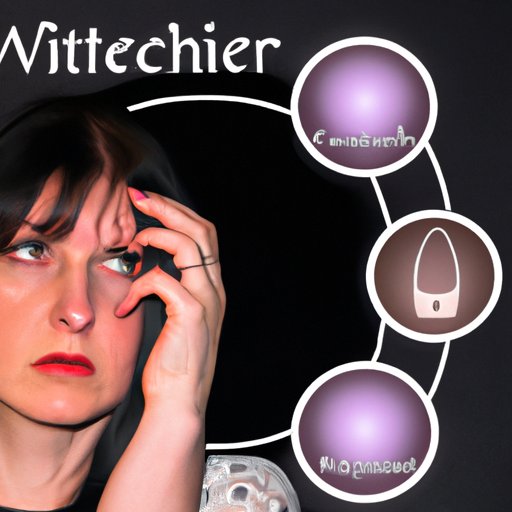
Introduction
Witchcraft is an ancient practice that refers to the use of supernatural powers to influence, harm, or benefit people. Despite the negative connotation associated with witchcraft, many people still practice it today and believe in its effects. Unfortunately, for some people, witchcraft can cause harm and suffering, even if they don’t believe in it. This article aims to provide readers with information on how to know if they are victims of witchcraft, including common symptoms, detection methods, prevention and defense measures, and ways to break the spell.
Symptoms of Witchcraft
Some people believe that certain physical, mental, and emotional symptoms can manifest when someone has been affected by witchcraft. These symptoms can range from mild to severe and can vary depending on the type of spell and the person’s susceptibility. Here are some common signs and symptoms:
- Physical symptoms: unexplained bruises, scratches, or rashes, sudden illnesses or injuries, extreme fatigue or weakness, loss of appetite or thirst, and difficulty sleeping.
- Mental symptoms: confusion, forgetfulness, frequent nightmares, sudden mood swings, and irrational thoughts or behaviors.
- Emotional symptoms: anxiety, fear, paranoia, depression, and feelings of being watched or followed.
It is important to note that these symptoms can also indicate other underlying medical or psychological conditions. Therefore, it is essential to consult a medical professional for an accurate diagnosis.
Types of Witchcraft
Witchcraft is present in various cultures and traditions and comes in different forms. Here are some types of witchcraft and their corresponding symptoms:
- African witchcraft: involves casting spells, hexes, or curses that can cause misfortune, illness or even death. Symptoms may include unexplained pain, infertility, loss of money, or job loss.
- European witchcraft: includes the use of charms, potions, and spells to harm or benefit someone. Symptoms may include feeling isolated, mood changes, and unexplained physical symptoms.
- Asian witchcraft: involves the use of amulets, talismans, and incantations. Symptoms may include confusion, hallucinations, and unexplained physical symptoms.
- Mexican witchcraft: includes the use of “brujeria,” a form of folk magic that may involve spells, curses, and rituals. Symptoms may include unexplained physical pain, nightmares, and depression.
It is crucial to note that not all cultures and traditions engage in witchcraft. It is also essential to be respectful of other cultures and avoid stereotyping or stigmatizing people who believe in witchcraft.
Methods to Detect Witchcraft
There are various methods individuals can use to detect witchcraft. These include:
- Scrying: involves looking at an object, such as a crystal or water, to gain insight into a situation or person’s character.
- Divination: involves the use of tools such as tarot cards, runes, or pendulums, to gain insight into a situation or person’s character.
- Observing unusual behavior: if an individual’s behavior does not match their usual pattern, they could be under the influence of witchcraft.
- Physical detection: some people use dowsing rods or other instruments to detect energy imbalances or disturbances.
It is important to note that these methods are not scientifically proven and may not always provide an accurate diagnosis. Therefore, it is essential to consult a medical professional for an accurate diagnosis before seeking help from a practitioner of the supernatural.
Prevention and Defense Against Witchcraft
There are several ways an individual can protect themselves from witchcraft, including:
- Avoid sharing personal information: individuals should avoid sharing their personal information with strangers, including their name, birth date, or address.
- Wear protective talismans and charms: some people believe that wearing protective talismans and charms can keep them safe from witchcraft.
- Perform rituals: some people believe that performing rituals, such as burning sage or lighting candles, can keep negative energy at bay.
- Avoid dark magic: individuals should avoid engaging in dark magic, as it can attract negative energy and harm.
It is important to note that these methods are not scientifically proven and may not always provide protection against witchcraft. Therefore, it is essential to take preventive measures and seek professional help if needed.
Getting Rid of Witchcraft
Breaking the spell of witchcraft can be challenging, but it is possible. Various methods can be used depending on the severity and origin of the spell, including:
- Seeking help from more experienced people: individuals can seek help from experienced practitioners of the supernatural, such as healers, shamans, or priests.
- Using herbs and crystals: some people use specific herbs and crystals to break the spell of witchcraft, such as frankincense, rosemary, and black tourmaline.
- Performing rituals: some people perform rituals to break the spell of witchcraft, such as burning sage or reciting protective prayers.
- Seeing a medical professional: it is essential to consult a medical professional for an accurate diagnosis and treatment of any underlying medical or psychological condition.
It is important to note that breaking the spell of witchcraft should not involve engaging in dark magic or seeking revenge. Instead, it should focus on healing and restoring balance.
Conclusion
Witchcraft can harm and affect people’s lives, even if they don’t believe in it. The symptoms of witchcraft can be physical, mental, or emotional, and it is essential to seek a medical professional for an accurate diagnosis. There are various ways to detect, prevent and defend against witchcraft, including performing rituals, wearing protective talismans, and avoiding dark magic. Breaking the spell of witchcraft can be challenging, but it can be done through seeking help from experienced people, using herbs and crystals, or performing rituals. Understanding witchcraft is essential to protect oneself from it, and it is crucial to seek support if someone believes they are victims of witchcraft.




